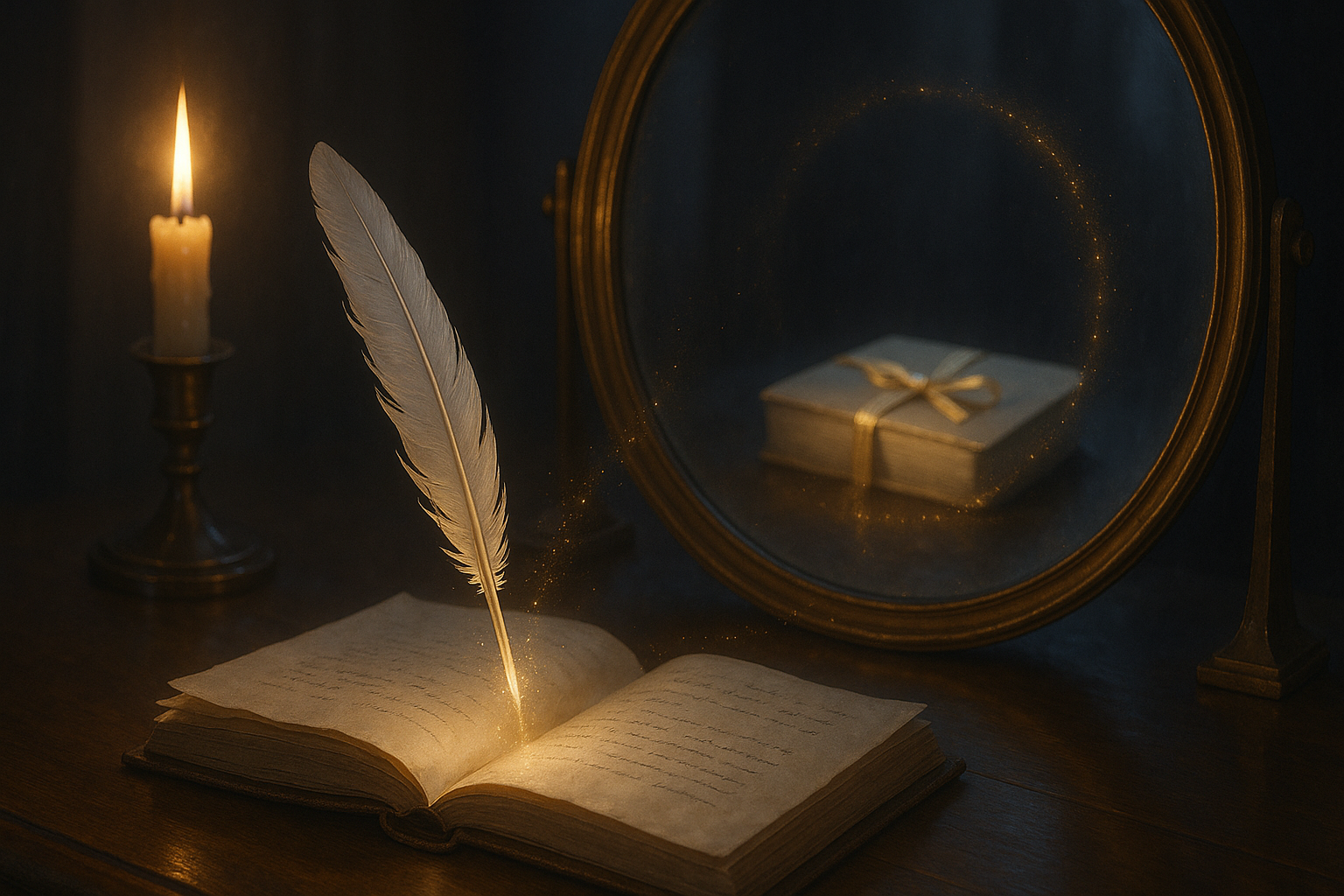☽⋆☾
☽⋆☾

The Alchemy of Editing
How a Manuscript Becomes Magical
☽⋆☾
Every writer begins with raw material — words full of promise but still finding their shape. Editing is the quiet art that transforms that rawness into radiance. It’s not simply about correction or polish, but discovery: uncovering the heart of a story and helping its voice shine through. Here we will step into the alchemist’s workshop to explore how editors turn rough drafts into living, luminous prose — and how, in the process, every story becomes a little more magical.
The Nature of Transformation
☽⋆☾
Every manuscript begins as something raw and luminous — a constellation of ideas, emotions, and images still finding their orbit. In its early state, it hums with potential, wild and untamed, like gold dust swirling in the crucible. The editor’s task is not to tame it, but to transform it — to channel that bright chaos into coherence without dimming its glow.
Editing is often mistaken for correction, for the fussy alignment of commas and the chasing of errant spaces. In truth, it’s far more alchemical. It’s the art of seeing the story that hides beneath the words — the shimmering pattern obscured by excess ore. The editor steps into the workshop not as a judge, but as an interpreter of energy, shaping the text until every element hums in harmony with the author’s intent.
This process is invisible to most readers, as all true enchantments are. But to those who write — and those who edit — it is unmistakable. It’s the slow transmutation of thought into clarity, emotion into language, and language into connection. What begins as a draft of raw imagination becomes, through careful turning and stirring, something radiant and alive: a masterpiece awakened.
The First Transmutation
Finding the Heart of the Story
☽⋆☾
Every act of transformation begins with discovery. Before anything can be refined, the editor must first uncover what the story is truly about — its core intention, its emotional pulse. This is the earliest stage of editing, where we work with shape and structure rather than style. It’s less about polishing sentences and more about understanding the beating heart beneath them.
At this stage, an editor reads like a detective and a cartographer combined. We’re searching for clues to the author’s purpose — the central thread that ties every character, scene, and idea together. We ask questions constantly: What is this story trying to say? Why now? Why through these characters? When that purpose is buried, the prose might look fine on the surface but feel hollow underneath. Our job is to uncover what’s already there, then help the writer bring it to the forefront.
Practically, this means examining structure and flow: does each chapter move the story forward, or does it wander? Are the stakes clear? Do characters evolve in ways that feel earned? We look for pacing that drags, tension that dissolves too early, emotional beats that could resonate more deeply. It’s an exercise in seeing the skeleton beneath the skin.
But it’s also about tone and cohesion. The editor listens for mismatched rhythms — places where a scene promises one emotion but delivers another, or where the voice slips without the writer realising. We spot patterns the author can’t see because they’re standing too close to the work. We trace where the story’s energy surges and where it fades. And when we’ve mapped it out, we can show the writer not just what is happening, but why it isn’t quite working yet.
This is the quiet, thoughtful stage of alchemy — part analysis, part intuition. It doesn’t involve heavy rewriting; it’s a conversation between what the story wants to be and what it currently is. Once that dialogue begins, the fog lifts. The path ahead becomes visible. The story begins to find its true form — and that’s when the real refinement can begin.
Related Service: The Runic Circle — Developmental editing, making story from structure
Distillation and Refinement
Language as Potion
☽⋆☾
Once the story’s foundation is sound, the attention turns to language — the medium through which the magic flows. This is the stage where editing becomes delicate, precise, almost musical. Each sentence is weighed not for correctness alone, but for how it moves, sounds, and feels. It’s where prose begins to hum with intention.
The work here resembles distillation: boiling away the excess so that only the purest essence remains. Sometimes that means trimming repetition or softening heavy phrasing; sometimes it means adding rhythm, warmth, or contrast where the language has gone flat. A paragraph that once rambled becomes a clean current of thought. Dialogue begins to sound like something real people might say. The story’s tone settles into its natural voice.
From the technical side, this is where line editing lives — the intersection between art and grammar. The editor examines clarity, flow, and consistency. We smooth transitions so one idea flows into the next without friction. We adjust sentence length to control pacing — short and sharp for tension, long and lyrical for reflection. Word choice becomes a kind of chemistry: finding the term that carries the exact emotional charge the scene requires.
We also watch for rhythm and emphasis — where sentences trip, where paragraphs breathe. A single misplaced adjective can pull focus from what matters; a weak verb can drain a moment’s vitality. The goal is not to change the author’s voice, but to amplify it — to make the language sing in the same key as the story itself.
At its best, this stage feels like balancing ingredients in a living potion. Each drop, stir, and whisper of change shifts the mixture closer to perfect harmony — volatile elements settling into something luminous and whole. By the end, the writing flows so naturally that readers never see the work behind it — they simply feel its effect. That invisibility is the true mark of refined prose: the potion so perfectly blended that the magic tastes effortless.
Related Service: The Charm of Clarity — Line editing to refine the rhythm and magic of your prose
Transmutation
Balancing Art and Logic
☽⋆☾
Every edit walks the line between instinct and precision. This stage — the transmutation — is where the craft deepens: where creative intuition meets the clear-eyed discipline of language. By now, the story’s structure is solid and the prose refined, but the text still holds subtle imbalances that can shift the reader’s experience. The editor’s role is to sense those fractures and bring the elements into perfect equilibrium.
Transmutation is about cohesion. We look at how all the parts — plot, pacing, tone, and theme — fuse together. Do the emotional highs and lows flow naturally? Does the voice remain steady through every chapter, or does it waver? This is the moment to ensure that what the author meant to say is exactly what the reader will feel. It’s equal parts analysis and artistry.
On the logical side, we check for consistency — of details, of language, of time. The tiny rules of continuity that, when broken, pull the reader out of the spell. A change in tense, an eye colour that shifts, a timeline that contradicts itself — these are the cracks that let disbelief creep in. The editor closes them, quietly, invisibly.
But it’s not just about catching errors; it’s about maintaining resonance. Too much precision can sterilise a story, just as too much freedom can blur it. The editor works in both worlds — one hand steady on the ledger of logic, the other tracing the invisible lines of rhythm and mood. When balance is achieved, the story feels effortless, inevitable — as if it could never have been any other way.
This is the most mysterious stage of editing, because it’s as much felt as it is reasoned. It’s where the technical and the intuitive merge, where the text finally transforms from crafted prose into living narrative. In alchemical terms, this is the moment when base metals turn to gold — or in the editor’s lexicon, when words begin to breathe.
Related Service: The Polishing Potion — Copyediting to harmonise artistry and accuracy
The Final Polish
Summoning the Shine
☽⋆☾
When the deeper work is done, only the surface remains — that last layer of refinement where the text catches the light. This is the stage most people picture when they think of editing: the gleam of precision, the hunt for errors, the immaculate finish. But in truth, it’s less about correction than calibration. Every mark is a quiet act of care.
At this stage, the editor steps back from structure and rhythm to focus on the fine-grain details that shape the reader’s experience. We look for what might distract: a missing comma, an inconsistent capital, a space too wide or too narrow. These things seem small — and they are — but like hairline cracks in glass, they catch the eye. The reader might not know why something feels off, only that the spell has momentarily broken. Our task is to make sure it never does.
Technically, this phase includes proofreading and final checks for consistency — typography, spelling, formatting, style. But it’s also where the prose receives its last infusion of clarity. Each correction strengthens the text’s transparency, ensuring that nothing stands between the story and the reader’s immersion. The magic, once elusive, now shines through unobstructed.
The final polish is quiet work. There are no grand transformations here, no sweeping changes — only precision and patience. Yet this stage completes the circle. It seals the enchantment. The editor closes the manuscript knowing every word now serves the story faithfully, every page gleams with intent. The spell is ready to be cast.
Related Service: The Final Glamour — Proofreading to perfect the almost perfect
Editing doesn’t create the magic. It awakens it.
Every story already holds its spark — the vision, the voice, the pulse that makes it uniquely yours. The editor’s craft is simply to uncover that brilliance, layer by layer, until the words reflect it clearly.
When the final page gleams, what remains isn’t the editor’s touch but the author’s intent, fully realised. The transformation is complete: the draft becomes art, the art becomes connection, and the story finally shines with its true voice — clear, confident, and alive.
To Awaken the Magic in your Masterpiece, just click the seal to open the Writer’s Spellbook and explore the enchantments within.





